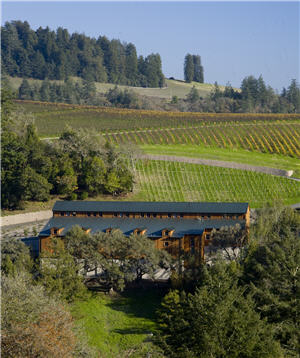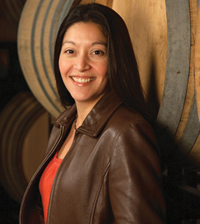

Freestone Vineyards' efforts with Pinot Noir and Chardonnay are showing the great potential of the Freestone area of Sonoma County.
Sonoma County (County Appellation)
A Napa Valley Winery Puts a Sonoma County Winery on the Map
A pioneering, multi-million investment by Joseph Phelps Vineyards in an unvetted area of Sonoma County has directed attention to Freestone.
by
Dan Berger
February 2, 2009
 he name is Freestone and it is destined to be one of the most important American Viticultural Appellations of them all. Right now, however, it is a nascent wine region in Sonoma County populated mainly by adventurous pioneers who might be called a tad pazzo.
he name is Freestone and it is destined to be one of the most important American Viticultural Appellations of them all. Right now, however, it is a nascent wine region in Sonoma County populated mainly by adventurous pioneers who might be called a tad pazzo.
Western Sonoma County is loaded with small blocks of land that barely support wine grapevine life. These are hard by the sea or within salt spray of the not-so-Pacific. It is cold here. One summer day last September, my wife and I drove to the coast to walk on the sand at Goat Rock State Beach near the terminus of the Russian River. The temperature inland was over 90°, but after a few minutes at the beach we realized we needed winter coats to withstand temperatures in the 50s and strong breezes.
On the drive back toward Santa Rosa, the winds never died down as we stopped at the Wild Flower Bakery on the Bohemian Highway in what is called Freestone. Though temperatures had risen to the high 60s, it was still cool enough for jackets.

The Freestone area gets the same sort of fog that defines the boundaries of Russian River Valley.
This retards growth of the vines and reduces total photosynthesis in two ways: fewer hours of total sunlight, and closure of the stomates (leaf pores), which the vine senses to be a micro-drought and shuts down briefly to preserve moisture. This last act slows flavor maturity and sugar development, and puts the vine, in some vintages, into a retarded-development mode.
Still, some of the best and longest-lived Pinot Noirs in the country have been grown here for the last decade, notably from passionate Dan Goldfield under his Dutton-Goldfield brand. And in particular, his Pinot from the ultra-cold Freestone Hill vineyard, farmed by Steve Dutton, is a stellar wine - but a wine that needs a lot of time in bottle to develop, so high is its typical acidity, so low is its pH, and so moderate is its alcohol.
From this description you can see that these wines are not showy or obvious when released. Which is why it’s a surprise that Joseph Phelps Vineyard, the acclaimed Cabernet house from the Napa Valley, would plunk down something like $30 million to put a vineyard and winery

Freestone’s winemaker Theresa Heredia.
This expensive wine project, moreover, has taken a decade to get off the drawing board and into a glass. Phelps’ Freestone project started with a land purchase in January 1999 in a quest for better Chardonnay land. A decade later, the first two releases were unveiled at a dinner for the press this past January,.
The dramatic vineyard property is located in some of western Sonoma County’s least hospitable soils. And Bill Phelps, son of the founder of the Phelps wine empire, knows that this was done for artistic rather than revenue-generating potential.
The idea is to make a statement, and that statement is: Freestone is California’s Burgundy.
If you believe that the greatest of all Chardonnay and Pinot Noir are from Burgundy, Bill Phelps would have the world believe, as he does, that Freestone is the best America can do with the same grape varieties. And more importantly that it competes with France’s best. And though both the Chardonnay and Pinot Noir released at the quiet unveiling are both superb, from the comments it was clear that red wine is this property’s destiny.Finding a location where Pinot will thrive and produce a world-class wine is the goal of literally thousands of passionate wine people. The French have always said that vines make the greatest wines when they live on the edge of disaster, ripening fully only now and then.
Phelps believes, and viticulturalists agree, that Freestone offers such conditions. It is defined by its cold winds, fog, and unrelenting cold nights. Freestone is less than five miles from the Pacific in an area so blanketed by fog most mornings that it’s downright frigid.
Former wine maker Craig Williams and winery president, the late Tom Shelton, both fell in love with this land, envisioning Chardonnay of an unbeatable character.

Freestone Vineyards winery building with its views of its vineyards was designed to fit into the landscape.
It then was discovered that Freestone may actually be too cold for Chardonnay. And Pinot was a risk as well. The first four Pinots off the acreage (2002-2005) proved that - they were oddly different from one another. Most were sold off, a few bottled as Fog Dog.
The red Freestone that debuted recently is a 2006, a blend of two hillside vineyards. One is the 40-acre Fog Dog Vineyard, the other, called Quarter Moon, is 55 acres and is in Sonoma Coast.
It is clear that Bill Phelps is passionate about the project. So passionate, in fact, that at the unveiling dinner, he was
 eager to serve the 2006 Freestone alongside wines from four high-priced competitors. The Freestone held its own and was one of three great wines on the table. The others: Dutton-Goldfield and Radio-Coteau.
eager to serve the 2006 Freestone alongside wines from four high-priced competitors. The Freestone held its own and was one of three great wines on the table. The others: Dutton-Goldfield and Radio-Coteau.
Phelps is committed to the Freestone name; so much so that the company made sure that there is no connection to Phelps’ Napa Valley label or image. And Phelps went to some lengths to guarantee that he would own the rights to the name Freestone.
It had been a wine brand trademarked by Rudy von Strasser of Von Strasser Winery in the Napa Valley, a dedicated fly fisherman. Von Strasser said the name came “from [fly] fisherman's nomenclature. Freestone riv










 READER FEEDBACK: To post your comments on this story,
READER FEEDBACK: To post your comments on this story,




